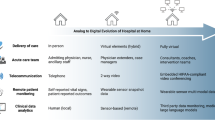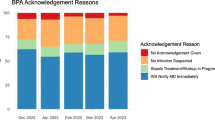Abstract
Objective
To increase compliance with standardized safe sleep recommendations for patients in a cohort of regional level III/IV neonatal intensive care units (NICUs) in accordance with recently revised guidelines issued by the American Academy of Pediatrics (AAP).
Study design
A regional quality improvement (QI) initiative led by a multidisciplinary task force standardized safe sleep criteria across participating NICU sites. Universal and unit-specific interventions were implemented via Plan-Do-Study-Act (PDSA) cycles with evaluation of compliance through routine crib audits, run chart completion, and Pareto chart analysis.
Results
Following QI implementation, compliance with safe sleep guidelines for eligible NICU infants improved from 34% to 90% from October 2019 through September 2022.
Conclusion
Compliance with early, consistent modeling of safe sleep practices nearly tripled in this cohort of regional NICUs. A standardized, timely approach to safe sleep transition demonstrated dramatic and sustained improvement in the practice and modeling of safe sleep behaviors in the NICU.
This is a preview of subscription content, access via your institution
Access options
Subscribe to this journal
Receive 12 print issues and online access
$259.00 per year
only $21.58 per issue
Buy this article
- Purchase on Springer Link
- Instant access to full article PDF
Prices may be subject to local taxes which are calculated during checkout





Similar content being viewed by others
Data availability
The datasets generated and/or analyzed during the current study are available from the corresponding author on reasonable request.
References
CDC. Data and Statistics - SIDS and SUID. Centers for Disease Control and Prevention. 2019. Available from: https://www.cdc.gov/sids/data.htm.
US Department of Health and Human Services: National Institutes of Health. Eunice Kennedy Shriver National Institute of Child Health and Human Development Safe to Sleep Public Education Campaign. Safe Infant Sleep Basics: Common SIDS and SUID Terms and Definitions, V4.1.6. 2019. Available from: https://safetosleep.nichd.nih.gov/safesleepbasics/SIDS/Common.
Batra EK, Lewis M, Saravana D, Corr TE, Daymont C, Miller JR, et al. Improving hospital infant safe sleep compliance by using safety prevention bundle methodology. Pediatrics. 2021;148:e2020033704.
Carlberg MM, Shapiro-Mendoza CK, Goodman M. Maternal and infant characteristics associated with accidental suffocation and strangulation in bed in US infants. Matern Child Health J. 2011;16:1594–601.
Goodstein, MH Safe sleep: Proper transition of NICU patients begins before discharge. AAP Clinical Report. June 21, 2021. Available from: https://publications.aap.org/aapnews/news/16450.
Goodstein MH, Stewart DL, Keels EL, Moon RY. Transition to a safe home sleep environment for the NICU patient. Pediatrics. 2021;148:e2021052045.
Moon RY, Darnall RA, Feldman-Winter L, Goodstein MH, Hauck FR, TASK FORCE ON SUDDEN INFANT DEATH SYNDROME. SIDS and other sleep-related infant deaths: updated 2016 recommendations for a safe infant sleeping environment. Pediatrics. 2016;138:e20162938.
Moon RY, Carlin RF, Hand I, TASK FORCE ON SUDDEN INFANT DEATH SYNDROME, COMMITTEE ON FETUS AND NEWBORN. Sleep-related infant deaths: updated 2022 recommendations for reducing infant deaths in the sleep environment. Pediatrics. 2022;150:e2022057990.
Rasinski KA, Kuby A, Bzdusek SA, Silvestri JM, Weese-Mayer DE. Effect of a sudden infant death syndrome risk reduction education program on risk factor compliance and information sources in primarily black urban communities. Pediatrics. 2003;111:e347–54.
Moon RY, Oden RP, Grady KC. Back to sleep: an educational intervention with women, infants, and children program clients. Pediatrics. 2004;113:542–7.
Gelfer P, Cameron R, Masters K, Kennedy KA. Integrating “Back to Sleep” recommendations into neonatal ICU practice. Pediatrics. 2013;131:e1264–70.
Yang L, Fu H, Zhang L. A systematic review of improved positions and supporting devices for premature infants in the NICU. Heliyon 2023;9:e14388.
Martin RJ, Herrell N, Rubin D, Fanaroff A. Effect of supine and prone positions on arterial oxygen tension in the preterm infant. Pediatrics. 1979;63:528–31.
Saiki T, Rao H, Landolfo F, Smith APR, Hannam S, Rafferty GF, et al. Sleeping position, oxygenation and lung function in prematurely born infants studied post term. Arch Dis Child Fetal Neonatal Ed. 2009;94:F133–7.
Prisk GK, Yamada K, Henderson AC. Pulmonary Perfusion in the prone and supine postures in the normal human lung. Cardiopulm Phys Ther J. 2008;19:23.
Rivas-Fernandez M, Roqué i Figuls M, Diez-Izquierdo A, Escribano J, Balaguer A. Infant position in neonates receiving mechanical ventilation. Cochrane Database Syst Rev. 2016;11:CD003668.
Keene DJ, Wimmer JE, Mathew OP. Does supine positioning increase apnea, bradycardia, and desaturation in preterm infants? J Perinatol. 2000;20:17–20.
Elder DE, Campbell AJ, Galletly D. Effect of position on oxygen saturation and requirement in convalescent preterm infants. Acta Paediatrica. 2011;100:661–5.
Elder DE, Campbell AJ, Larsen PD, Galletly D. Respiratory variability in preterm and term infants: effect of sleep state, position and age. Respir Physiol Neurobiol. 2011;175:234–8.
Ballout RA, Foster JP, Kahale LA, Badr L. Body positioning for spontaneously breathing preterm infants with apnoea. Cochrane Database Syst Rev. 2017;1:CD004951.
Elder DE, Campbell AJ, Doherty DA. Prone or supine for infants with chronic lung disease at neonatal discharge? J Paediatrics Child Health. 2005;41:180–5.
Drakulovic MB, Torres A, Bauer TT, Nicolas JM, Nogué S, Ferrer M. Supine body position as a risk factor for nosocomial pneumonia in mechanically ventilated patients: a randomised trial. Lancet. 1999;354:1851–8.
Azab SFA, Sherbiny HS, Saleh SH, Elsaeed WF, Elshafiey MM, Siam AG, et al. Reducing ventilator-associated pneumonia in neonatal intensive care unit using “VAP prevention Bundle”: a cohort study. BMC Infect Dis. 2015;15:314.
Heath JA, Zerr DM. Chapter 35: Infections acquired in the nursery: epidemiology and control. Infect Dis Fetus Newborn Infant. 2006;1179–205. https://doi.org/10.1016/B0-72-160537-0/50037-2.
Rocha G, Soares P, Gonçalves A, Silva AI, Almeida D, Figueiredo S, et al. Respiratory care for the ventilated neonate. Can Respir J. 2018;2018:7472964.
Bagucka B, De Schepper J, Peelman M, Van de Maele K, Vandenplas Y. Acid gastro-esophageal reflux in the 10 degrees-reversed-Trendelenburg-position in supine sleeping infants. Acta Paediatrica Taiwanica. 1999;40:298–301.
Orenstein SR, Whitington PF, Orenstein DM. The infant seat as treatment for gastroesophageal reflux. N Engl J Med. 1983;309:760–3.
Willett LD, Leuschen MP, Nelson LS, Nelson RM. Risk of hypoventilation in premature infants in car seats. J Pediatrics. 1986;109:245–8.
Jeffery HE, Megevand A. Why the prone position is a risk factor for sudden infant death syndrome. Pediatrics. 1999;104:263–9.
Rosen R, Vandenplas Y, Singendonk M, Cabana M, DiLorenzo C, Gottrand F, et al. Pediatric gastroesophageal reflux clinical practice guidelines: joint recommendations of the North American Society for Pediatric Gastroenterology, Hepatology, and Nutrition and the European Society for Pediatric Gastroenterology, Hepatology, and Nutrition. J Pediatr Gastroenterol Nutr. 2018;66:516–54.
Oyen N, Markestad T, Irgens LM, Helweg-Larsen K, Alm B, Norvenius G, et al. Combined effects of sleeping position and prenatal risk factors in sudden infant death syndrome: the Nordic epidemiological SIDS study. Pediatrics. 1997;100:613–21.
Shadman KA, Wald ER, Smith W, Coller RJ. Improving safe sleep practices for hospitalized infants. Pediatrics. 2016;138:e20154441–1.
Salm Ward TC, Balfour GM. Infant safe sleep interventions, 1990–2015: a review. J Community Health. 2015;41:180–96.
Hwang SS, O’Sullivan A, Fitzgerald E, Melvin P, Gorman T, Fiascone JM. Implementation of safe sleep practices in the neonatal intensive care unit. J Perinatol. 2015;35:862–6.
Hwang SS, Melvin P, Diop H, Settle M, Mourad J, Gupta M. Implementation of safe sleep practices in Massachusetts NICUs: a state-wide QI collaborative. J Perinatol. 2018;38:593–9.
Macklin JR, Gittelman MA, Denny SA, Southworth H, Arnold MW. The EASE quality improvement project: improving safe sleep practices in Ohio children’s hospitals. Pediatrics. 2016;138:e20154267–7.
Macklin JR, Gittelman MA, Denny SA, Southworth H, Arnold MW. The EASE project revisited: improving safe sleep practices in Ohio birthing and children’s hospitals. Clin Pediatrics. 2019;58:1000–7.
McMullen S, Lipke B, LeMura C. Sudden infant death syndrome prevention: a model program for NICUs. Neonatal Netw. 2009;28:7–12.
Voos KC, Terreros A, Larimore P, Leick-Rude MK, Park N. Implementing safe sleep practices in a neonatal intensive care unit. J Matern Fetal Neonatal Med. 2014;28:1637–40.
State of Maternal and Infant Health in Hamilton County, Ohio. 2023. Available from: https://www.cradlecincinnati.org/wp-content/uploads/2021/04/2020-Infant-Mortality-Report-Slide-Deck-Compressed.pdf.
Gutman CE, Scott PA, Morad A, Barker B, & Scott TA. Safe to sleep in Tennessee: a statewide quality improvement initiative. Am J Perinatol. 2023, https://doi.org/10.1055/s-0043-1768705.
Kaplan HC, Provost LP, Froehle CM, Margolis PA. The model for understanding success in quality (MUSIQ): building a theory of context in healthcare quality improvement. BMJ Qual Saf. 2011;21:13–20.
Langley GJ, Moen R, Nolan KM, Nolan TW, Norman CL, Provost LP. The improvement guide: a practical approach to enhancing organizational performance. 2nd ed. San Francisco, CA: Jossey-Bass; 2014.
Hilton K, Anderson A. IHI psychology of change framework to advance and sustain improvement. Institute for Healthcare Improvement: Boston; 2018.
Grazel R, Phalen AG, Polomano RC. Implementation of the American Academy of Pediatrics recommendations to reduce sudden infant death syndrome risk in neonatal intensive care units. Adv Neonatal Care. 2010;10:332–42.
Patton C, Stiltner D, Wright KB, Kautz DD. Do nurses provide a safe sleep environment for infants in the hospital setting? An integrative review. Adv Neonatal Care. 2015;15:8–22.
Aris C, Stevens TP, Lemura C, Lipke B, McMullen S, Cote-Arsenault D, et al. NICU nurses’ knowledge and discharge teaching related to infant sleep position and risk of SIDS. Adv Neonatal Care. 2006;6:281–94.
Hershberger ML, Peeke KL, Levett J, Spear ML. Effects of sleep position on apnea and bradycardia in high-risk infants. J Perinatol. 2001;21:85–89.
Vernacchio L, Corwin MJ, Lesko SM, Vezina RM, Hunt CE, Hoffman HJ, et al. Sleep position of low birth weight infants. Pediatrics. 2003;111:633–40.
Heath JA, Zerr DM. Infections acquired in the nursery: epidemiology and control. Infectious Dis Fetus Newborn Infant. 2006;19:1179–205.
Garland JS. Strategies to prevent ventilator-associated pneumonia in neonates. Clin Perinatol. 2010;37:629–43.
Eichenwald EC, COMMITTEE ON FETUS AND NEWBORN. Diagnosis and management of gastroesophageal reflux in preterm infants. Pediatrics. 2018;142:e20181061.
Brenner RA, Simons-Morton BG, Bhaskar B, Mehta N, Melnick VL, Revenis M, et al. Prevalence and predictors of the prone sleep position among inner-city infants. JAMA. 1998;280:341.
Goetter MC, Stepans MBF. First-time mothers’ selection of infant supine sleep positioning. J Perinat Educ. 2005;14:16–23.
Smith VC, Hwang SS, Dukhovny D, Young S, Pursley DM. Neonatal intensive care unit discharge preparation, family readiness and infant outcomes: connecting the dots. J Perinatol. 2013;33:415–21.
Sneath N. Discharge teaching in the NICU: are parents prepared? An integrative review of parents’ perceptions. Neonatal Netw. 2009;28:237–46.
Napolitano S, King A, Amsterdam A, Khattar D, Greenberg J, Enlow E. Safe sleep truths: caregivers’ perspective on home challenges from a NICU cohort [abstract]. In: Pediatric Academic Societies Annual Meeting, Poster presentation; 2020.
Acknowledgements
We acknowledge the Perinatal Institute, Cincinnati Children’s Hospital, our partnering sites, the members of our multidisciplinary team, and all who participated in this work for their support.
Funding
Internal funding and project support were provided by the Perinatal Institute and the James M. Anderson Center for Health Systems Excellence at Cincinnati Children’s Hospital Medical Center.
Author information
Authors and Affiliations
Contributions
DKP and SKN conceptualized and designed the study, collected and analyzed study data, drafted the initial manuscript, and critically reviewed and revised the manuscript. NLB refined the study design, supervised study activities and data collection, analyzed data, and critically reviewed and revised the manuscript. MEBD and PF refined the study design, collected and analyzed study data, and critically reviewed and revised the manuscript. RDH collected and analyzed data, and critically reviewed and revised the manuscript. All authors approved the final manuscript as submitted and agree to be accountable for all aspects of the work.
Corresponding author
Ethics declarations
Competing interests
The authors declare no competing interests.
Ethics approval
This study was reviewed by the CCHMC Institutional Review Board and deemed exempt, IRB ID 2019-1152.
Additional information
Publisher’s note Springer Nature remains neutral with regard to jurisdictional claims in published maps and institutional affiliations.
Supplementary information
Rights and permissions
Springer Nature or its licensor (e.g. a society or other partner) holds exclusive rights to this article under a publishing agreement with the author(s) or other rightsholder(s); author self-archiving of the accepted manuscript version of this article is solely governed by the terms of such publishing agreement and applicable law.
About this article
Cite this article
Napolitano, S.K., Boswell, N.L., Froese, P. et al. Early and consistent safe sleep practices in the neonatal intensive care unit: a sustained regional quality improvement initiative. J Perinatol (2024). https://doi.org/10.1038/s41372-023-01855-6
Received:
Revised:
Accepted:
Published:
DOI: https://doi.org/10.1038/s41372-023-01855-6



